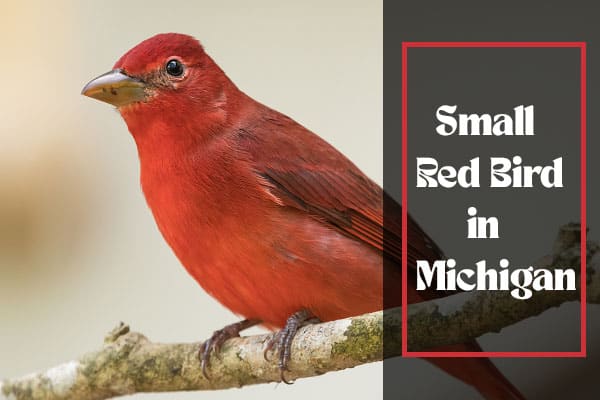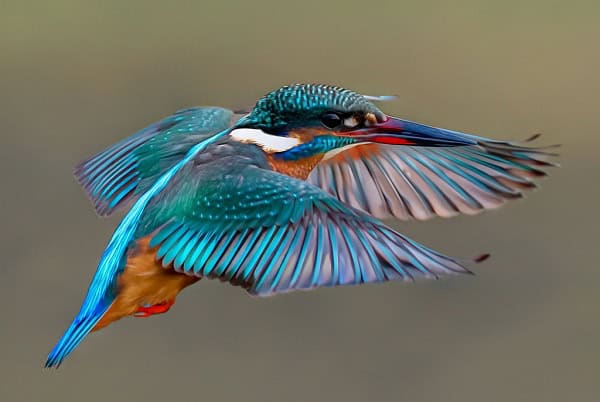11 Types Of Red Birds in Michigan (With Pictures)
Michigan is full of colorful red birds. They add beauty to the state’s different places. You’ll learn about 11 kinds of red birds here, like the Northern Cardinal and the Vermilion Flycatcher.
These birds make Michigan more beautiful. They also offer great chances for birdwatching. Knowing how to identify Michigan birds helps you see their beauty.

Key Takeaways
- Michigan hosts a variety of red birds, enriching its landscapes.
- The Northern Cardinal is one of the most recognizable red birds in Michigan.
- Identifying these birds enhances your birdwatching experience.
- Each species has unique characteristics and habitats.
- This guide covers both common and rare red birds found in the state.
Introduction to Red Birds in Michigan
Michigan is known for its beautiful landscapes and wildlife. Red birds add color to the state’s ecosystems, and birdwatching in Michigan lets you see these birds in their homes.
Popular red birds like the Northern Cardinal and Scarlet Tanager enrich Michigan’s bird scene. Watching these birds is exciting, especially during migrations. They help keep the environment balanced by spreading seeds and controlling pests.
Knowing about different red birds can help you enjoy birdwatching more. It can also show you how important they are to Michigan’s wildlife. Birdwatching in Michigan is full of joy and discovery.
The Importance of Observing Red Birds
Watching red birds has many benefits. It helps us feel better and learn about nature. Studies show that being outside is good for our minds.
Many people find birdwatching helps them relax and focus better. Red birds tell us about the health of our environment, and by watching them, we learn about the world around us.
Watching nature helps us connect with the world. It makes us curious about wildlife. This curiosity helps us want to protect these birds and their homes.
| Benefit | Description |
|---|---|
| Mental Well-being | Engaging with nature reduces stress and improves mood. |
| Environmental Awareness | Understanding red birds helps recognize the health of ecosystems. |
| Conservation Efforts | Increased knowledge of biodiversity encourages participation in protection initiatives. |
The Top 6 Most Common Red Birds in Michigan
Birdwatchers love to find out about local birds. Michigan is a great place to see common red birds. Knowing these birds helps you better understand Michigan bird identification and makes birdwatching more fun.
Here are the top six most commonly seen red birds in Michigan:
- Northern Cardinal
- Scarlet Tanager
- American Robin
- Red-bellied Woodpecker
- Rose-breasted Grosbeak
- Red-headed Woodpecker
This list is great for birdwatchers who want to learn Michigan bird identification. These birds are colorful and sing beautiful songs. They also have special features that help you tell them apart. Watching these common red birds in Michigan will make you love nature more.
| Bird Species | Percentage of Sightings |
|---|---|
| Northern Cardinal | 34% |
| Scarlet Tanager | 22% |
| American Robin | 15% |
| Red-bellied Woodpecker | 12% |
| Rose-breasted Grosbeak | 8% |
| Red-headed Woodpecker | 6% |
1. Northern Cardinal
The Northern Cardinal is a beautiful bird loved by many. It’s often seen in Michigan. Its bright colors and songs make it a favorite among bird watchers and homeowners.

Description
The Northern Cardinal stands out with its bright red color and crest. Males have bright red feathers, looking stunning in Michigan’s woodlands. Females have softer brown colors with reddish highlights, making them interesting to look at.
Identification Tips
To spot these red birds, look for males with bright red feathers and a black mask. Females are harder to spot but are worth the effort. They are about 8.3 to 9.1 inches long.
Habitat
Northern Cardinals live in many places, like Michigan’s woodlands, gardens, and backyards. They can live in different places all year. They love to eat seeds and berries, making them fun to watch.
Fun Fact
Did you know male Northern Cardinals have complex songs? Their beautiful songs help them talk to their mates and keep intruders away. Watching them in your backyard is a joy.
2. House Finch

The House Finch is a bird you can see in many places in Michigan. It has a brown body with bright red on the male’s face and chest. This makes it a favorite among bird watchers.
Description
Male House Finches have bright red on their crown and chest. Female House Finches are browns and grays. This helps you tell them apart from other birds.
Identification Tips
To spot a House Finch, look for its brown-streaked body and the males’ red. Also, listen for their happy songs in cities. They like gardens, parks, and roadsides.
Habitat
House Finches live in many places, especially cities. They adapt well to human changes, finding food and homes easily. They even live in patios and building eaves.
Fun Fact
Did you know House Finches came to the east in the 1940s? They quickly changed to live with humans. This shows their ability to thrive in cities in Michigan.
3. Scarlet Tanager
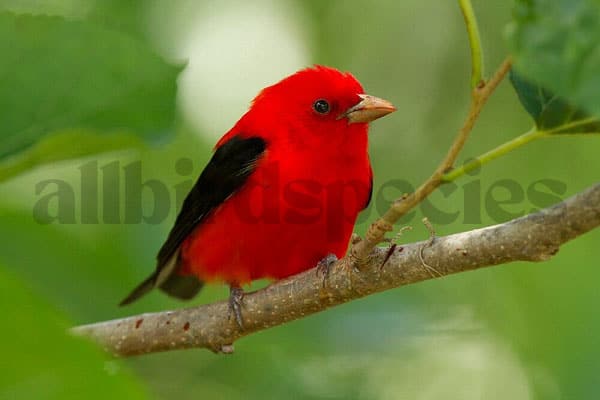
The Scarlet Tanager is a bird that catches the eye in Michigan. It has bright red and black colors. This makes it a favorite among bird lovers.
You’ll learn how to spot the Scarlet Tanager. You’ll also find out where it likes to live. Plus, you’ll discover some cool facts about this bird.
Description
Males have bright red feathers all over. This makes them easy to see. Females are olive-yellow, which is harder to spot.
Both males and females have black wings and tails. Their big, yellowish bills are also unique.
Identification Tips
To spot a Scarlet Tanager, look for these things:
- Bright red body (males) and olive-yellow body (females)
- Black wings and tail
- Large, conical bill that is often yellowish in color
Listen for their song too. It’s a series of short, sweet notes from the trees.
Habitat
Scarlet Tanagers love deciduous forests. They live in the leafy trees. During migration, they visit wooded areas in Michigan.
They look for insects and ripe fruit to eat.
Fun Fact
Scarlet Tanagers migrate to South America in the fall. They travel a long way from their homes. This shows how strong these birds are.
4. Red-Headed Woodpecker

The Red-Headed Woodpecker is a standout in Michigan. Its bright red head and black-and-white body make it a favorite among birdwatchers.
Description
This bird has a fully red head and white patches on its wings. Its bright colors help you tell it apart from other birds. It’s about the same size as a robin, around 7.5 to 9 inches long.
Identification Tips
To spot a Red-Headed Woodpecker, look for these signs:
- Bright redhead
- Black back and wings
- White belly and face
- Sturdy, pointed bill
These features make it easy to find, even for beginners.
Habitat
Red-headed woodpeckers live in open woodlands, parks, and areas with dead trees. These places offer nesting sites and food. They also like agricultural areas for insects and tree sap.
Fun Fact
A cool fact about Red-Headed Woodpeckers is how they store food. They can hide snacks in tree crevices. This shows their smart foraging ways.
5. Summer Tanager
The Summer Tanager is a bird that catches the eye. It’s the only all-red bird in Michigan. This makes it stand out to birdwatchers.
Male Summer Tanagers are bright red. Females are yellowish-green. This makes it easy to tell them apart.

Description
The male Summer Tanager is all red, while the females are yellowish-green. This color difference helps bird lovers tell them apart.
Young birds and females are harder to spot. They don’t have the bright colors of males.
Identification Tips
- Look for the solid red coloration of males, which sets them apart from the more muted tones of females.
- Observe their unique, melodic song, which features a series of sweet notes that often fill the air during the summer months.
- For a complete picture of this majestic bird, note the soft, rounded wings and long, slender body.
Habitat
Summer Tanagers like open woodlands. They need places with lots of insects. This is where they find bees and wasps.
You can see them in trees. They look for their next meal.
Fun Fact
Summer Tanagers eat bees and wasps. This is rare in North America. It shows their special role in nature.
6. Red Crossbill

The Red Crossbill is a special bird with a crossed bill. This helps it get seeds from pine cones in Michigan’s forests. Males are bright red with dark wings, and females are less bright but still have a special bill.
Description
The Red Crossbill is part of the Finch family. It has a bill that crosses at the tips. This helps it eat seeds, which are a big part of its diet. Males are easy to spot because of their bright color. Females are a bit less bright but still have a special bill.
Identification Tips
To spot a Red Crossbill, look for these things:
- Bill Shape: The crossed bill is the most telling sign.
- Coloration: Males are bright red, while females are yellowish-brown.
- Size: They are about the same size as a house finch.
Habitat
Red Crossbills like forests with lots of pine and spruce trees. In Michigan, they live in dense forests. When food runs out, they move to find more.
Fun Fact
Red Crossbills make different sounds for different activities. This makes them interesting to watch. In Michigan, they are often seen when pine cones are plentiful.
Rare and Seasonal Red Birds in Michigan
Michigan’s different landscapes are perfect for many rare red birds. Birdwatchers love these birds when they migrate. Seeing these birds adds to Michigan’s bird life, making it special for birders.
Two examples are the purple finch and Vermilion Flycatcher. The Purple Finch is bright red and likes forests. It is seen in fall and spring.
The Vermilion Flycatcher is less common but stunning. It has bright red feathers. It likes open areas with trees and shrubs for hunting.
The Upper Peninsula is great for birdwatching camping trips. It’s full of different birds, including red ones. Watching birds here helps celebrate Michigan’s nature.
7. Pine Grosbeak
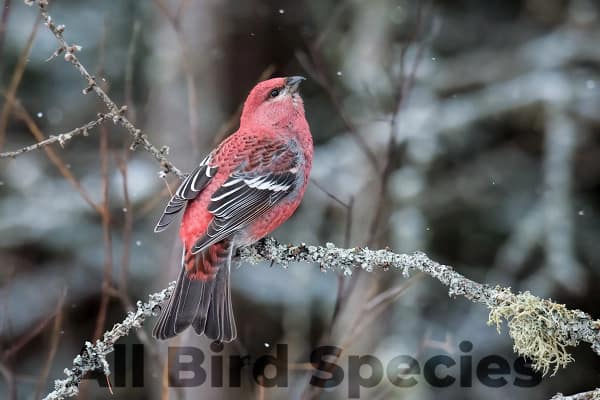
The Pine Grosbeak is a bird to watch in Michigan’s winter. It’s big and brightly colored, and you’ll see it against the snow.
Description
The male Pine Grosbeak is bright pink, and the females are yellowish-gray. Their colors make them easy to spot.
Identification Tips
It’s easy to tell a Pine Grosbeak by its size and colors. Here’s what to look for:
- They are as big as a medium chicken.
- Males are bright pink.
- Females are yellowish-gray with small marks.
- Listen for their soft songs to help spot them.
Habitat
Pine Grosbeaks live in northern forests. They like conifer trees. They eat seeds, berries, and fruits.
Fun Fact
Pine Grosbeaks are fun to watch. They eat together in winter. This makes birdwatching in Michigan more beautiful.
| Attribute | Pine Grosbeak |
|---|---|
| Size | Medium to large |
| Male Plumage | Bright reddish-pink |
| Female Plumage | Yellowish-gray |
| Habitat | Coniferous forests |
| Diet | Seeds, berries, fruits |
8. Common Redpoll
The Common Redpoll is a small red bird that makes winter brighter. It has a red crown and rosy breast. Its brown and white streaks make it stand out.

These birds often fly in groups. They do this more in cold months to find food.
Description
This bird is about 5 to 6 inches long and weighs 0.5 ounces. Males have a brighter red crown than females. Both have similar shapes and markings.
Common Redpolls are built for cold weather. Their sturdy bodies help them survive harsh winters.
Identification Tips
To spot Common Redpolls, look for their red caps and black face masks. Seeing them in groups is a great way to watch their behavior. Listen for their thin, melodic calls to find them.
Habitat
Common Redpolls live in open forests and weedy areas. In winter, they visit backyards for food. They like places with birch, alder, and conifers.
This habitat is key for their survival in cold months.
Fun Fact
Common Redpolls can handle very cold temperatures. They burrow into snow to stay warm. This skill helps them survive Michigan’s winters.
9. Cassin’s Finch
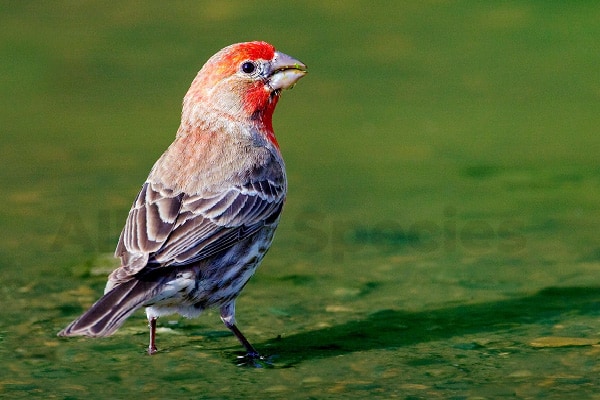
The Cassin’s Finch is a rare red bird in Michigan during migration. Males have a pinkish-red crown and a bright red throat. Females are brown with heavy streaking. These features help you spot them among other finches.
Description
Males are a mix of rosy colors. Females are earthy and blend in well. They are the same size as other finches, making them fun to watch.
Identification Tips
- Look for the pinkish-red crown in males.
- Observe the heavily streaked brown patterns in females.
- Listen for their cheerful songs and calls, a great way for identifying Cassin’s Finch during migrations.
Habitat
The Cassin’s Finch lives in coniferous forests. These forests are key during their migrations. Look for them in mountainous or forested areas during migration.
Fun Fact
A cool fact about Cassin’s Finches is their social nature. They hang out with other migratory birds. This makes their travels interesting to watch.
10. Purple Finch

The Purple Finch adds color with its raspberry-red feathers. Males show off this bright color, which bird watchers love. Females have brown feathers with streaks, making them harder to spot.
Description
Males have a bright raspberry-red color that shines against their brown wings. This makes them easy to see in forests. Females blend in with their brown and streaked feathers.
Identification Tips
- Look for the raspberry-red males which have strikingly bright plumage.
- Females can be recognized by their overall brown coloring, but pay attention to the streaks.
- Listen for their cheerful, musical notes that add to their identification.
Habitat
Purple Finches live in mixed and coniferous forests. They also like areas with trees and shrubs near homes. In winter, they are seen all over Michigan.
Fun Fact
Did you know Purple Finches eat seeds and insects? This shows how they adapt to their environment. There’s more to them than their bright color.
11. Vermilion Flycatcher

The Vermilion Flycatcher is a beautiful bird with a bright red body and dark brown wings. It lives in the southwestern United States and is a treat for bird lovers when it visits Michigan.
Male Vermilion Flycatchers are very colorful. Females are less bright but still pretty, with pale colors and red hints on their bellies.
Description
Seeing a Vermilion Flycatcher can make birdwatching exciting. Males are easy to spot because of their bright red. Females are harder to see because they blend in.
Look for them in open areas near water. This is where they like to be.
Habitat
Vermilion Flycatchers like open spaces near rivers, ponds, and marshes. They need places with lots of insects to eat. Even though they don’t live here often, seeing one in Michigan is special.
Fun Fact
A cool thing about Vermilion Flycatchers is how they catch insects. They sit up high and then jump down to catch them in the air. It’s fun to watch and shows how important they are in their ecosystem.
Read Our Previous Articles~
Frequently Asked Questions About Michigan Red Birds
Are magpies common in any areas of Michigan?
Magpies can be found in Michigan, primarily in the western regions. They are not as common as other birds, like crows or jays.
What’s the name of the bird that lives in the US Midwest?
The Red-winged Blackbird is a prominent bird in the Midwest, often found in wetland areas.
What Michigan bird could’ve dropped a black feather with a red patch?
The male Red-winged Blackbird fits this description, featuring red and yellow patches on its wings.
Do cardinal birds return to the same feeders every year?
Yes, Northern Cardinals often return to the same feeders year after year, particularly if food sources are reliable.
Which bird lays red eggs?
Birds like Marans and certain falcons can lay reddish eggs, though it’s rare for birds.
I noticed a bird around my house that was black in color…
You might have seen a male Red-winged Blackbird or possibly a Common Grackle, both of which are prevalent in Michigan.
What is your state’s bird?
The Northern Cardinal is the state bird of Michigan, known for its bright red color and distinctive song.
What are some of the iconic birds where you live?
In Michigan, iconic birds include the American Robin, Northern Cardinal, and Red-winged Blackbird.
What are the most common birds of prey in your area?
Common birds of prey in Michigan include the Red-tailed Hawk and the Bald Eagle.
Final Words on this Topic
Red birds are a vibrant and captivating part of Michigan’s avian diversity. From the striking Northern Cardinal to the elusive Pine Grosbeak, each species brings its own charm and beauty to the landscape. Birdwatchers and nature enthusiasts can find joy in spotting these stunning creatures throughout various habitats across the state.
Understanding their habits, appearance, and sounds enriches the experience of observing them in their natural environment. Whether you’re an experienced birdwatcher or just starting out, looking for red birds in Michigan can be both enjoyable and educational.
Keep your binoculars ready when exploring parks, backyards, or woodland areas—each sighting becomes a memorable moment that connects you with nature’s wonders. The next time you venture outside in search of these colorful feathered friends, remember how many unique types inhabit this beautiful region. Happy birdwatching!

